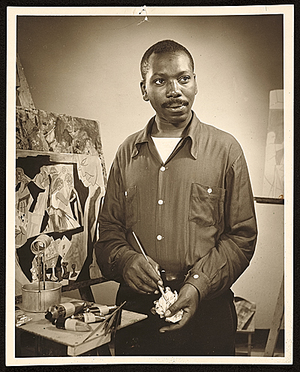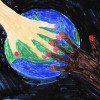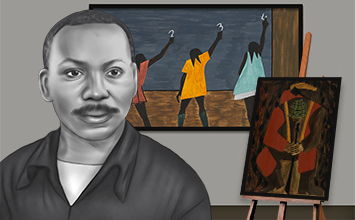jacob lawrence art
Jacob Lawrence was born September 7, 1917 in Atlantic City, New Jersey. Jacobs’s parents moved him and his siblings from the rural south, after which they divorced in 1924 [4] . His mother put him and his two younger siblings into foster care in Philadelphia. When he was 13, he and his siblings moved to New York City, where he reconnected with his mother in Harlem. Lawrence was introduced to art shortly after that when their mother enrolled him in after school classes at an arts and crafts settlement house in Harlem, called Utopia Children’s Center, in an effort to keep him busy. The young Lawrence often drew patterns with crayons. In the beginning, he copied patterns of his mother’s carpets. One of his art teachers noted great potential in Lawrence.
The “hard, bright, brittle” aspects of Harlem during the Great Depression inspired Lawrence as much as the colors, shapes and patterns inside the residents’ homes. “Even in my mother’s home,” Lawrence told historian Paul Karlstrom, “people of my mother’s generation would decorate their homes in all sorts of color. so you’d think in terms of Matisse.” [10] He used water-based media throughout his career. [6] Lawrence started to gain some notice for his dramatic and lively portrayals of both contemporary scenes of African-American urban life as well as historical events, all of which he depicted in crisp shapes, bright, clear colors, dynamic patterns, and through revealing posture and gestures. However, his mother still hoped he would choose a career in the Civil Service. [11]

Lawrence is among the best-known 20th-century African-American painters. He was 25 years old when he gained national recognition with his 60-panel Migration Series, painted on cardboard. The series depicted the Great Migration of African-Americans from the rural South to the urban North. A part of this series was featured in a 1941 issue of Fortune. The collection is now held by two museums: the odd-numbered paintings are on exhibit in the Phillips Collection in Washington, D.C., and the even-numbered are on display at MOMA in New York. Lawrence’s works are in the permanent collections of numerous museums, including the Philadelphia Museum of Art, the Museum of Modern Art, the Whitney Museum, the Phillips Collection, Metropolitan Museum of Art, the Brooklyn Museum, and Reynolda House Museum of American Art. He is widely known for his modernist illustrations of everyday life as well as epic narratives of African American history and historical figures.
Jacob Lawrence was born in 1917 in Atlantic City, New Jersey. Jacobs’s parents moved him and his siblings from the rural south to the north for a chance at a better life. They divorced in 1924, after which his mother put him and his two younger siblings into foster care in Philadelphia. When he was 13, he and his siblings moved to New York City, where he reconnected with his mother in Harlem. Lawrence was introduced to art shortly after that when their mother enrolled him in after school classes at an arts and crafts settlement house in Harlem, called Utopia Children’s Center, in an effort to keep him busy. The young Lawrence often drew patterns with crayons. In the beginning, he copied patterns of his mother’s carpets. One of his art teachers noted great potential in Lawrence.

Explore all 60 panels of Jacob Lawrence’s great American epic.
This website is produced by The Phillips Collection.

Casein tempera on hardboard – Hampton University Museum, Virginia
With This is Harlem, Lawrence transformed a busy Harlem neighborhood into a series of geometric abstract planes connected to each other by a limited, consistent color palette of brown, blue, yellow, red, black, white, and burnt-red-orange tones. On the roof of the buildings, rectangles and triangles in red, yellow, brown, and black create a back-and-forth interplay between abstraction and figuration. They appear to be chimneys and various structures and at the same time suggest geometric, abstract paintings. Similarly, the human figures populating the Harlem landscape, created with minimal detail and in the same unmodulated color tones Lawrence used for the landscape, appear to dissolve into abstract color planes as much as they represent unique actors, going about the business of daily life.

Working with a palette of browns, bright red, yellow-orange, black, white, and blue, Lawrence created his figures as non-naturalistic color blocks, their limbs elongated, their torsos concealed beneath blocky clothing, and their facial features simplified to eyes and mere outlines of a nose and mouth. These compositional decisions eliminate extraneous background details that would take away from the poignant emotions of the narrative. Art historian Elizabeth Hutton Turner has said of Lawrence’s works in series that they were conceived as “image and word” together, with the works’ “poetry” emerging from the “repetition of certain shapes” linking one panel to the next. In Frederick Douglass, the woven basket, made by slaves, acts as a reminder of slave labor, the work of the Black American journey to freedom, and the continual presence of an oppressive past even in a seemingly safer present. The red flower symbolizes hope, and its appearance in Frederick Douglass panels suggests the promise of a better life, even in the most dire of circumstances.
Panel 28 uses simplified forms, a limited color palette, and a clear narrative progression from left to right in tandem with evocative, descriptive text. A group of freed slaves huddle in a shelter, watching the carnage of a Civil War anti-draft riot with expressions of horror and sorrow. Lawrence divided the panel into three dramatic groups. The first group depicts two adults and a child, wide-eyed with fear as they witness the brutality of the riot. The second, middle group shows an older woman, symbolizing an older generation with memories of slavery and the commonality of violence, sheltering a young child who, perhaps unused to such scenes, is seemingly distracted, and grasps the woman’s thumb. The third grouping, a mother, father, and infant, symbolizes the hope and fear of a generation born at the cusp of great change and the promise of freedom throughout the United States tantalizingly at hand. Lawrence later recalled the work’s important political gestures as “some of the most successful statements I have made in my life .”
References:
http://www.wikiart.org/en/jacob-lawrence
http://lawrencemigration.phillipscollection.org/
http://m.theartstory.org/artist/lawrence-jacob/artworks/
http://m.theartstory.org/artist/lawrence-jacob/
http://en.m.wikipedia.org/wiki/Jacob_Lawrence
